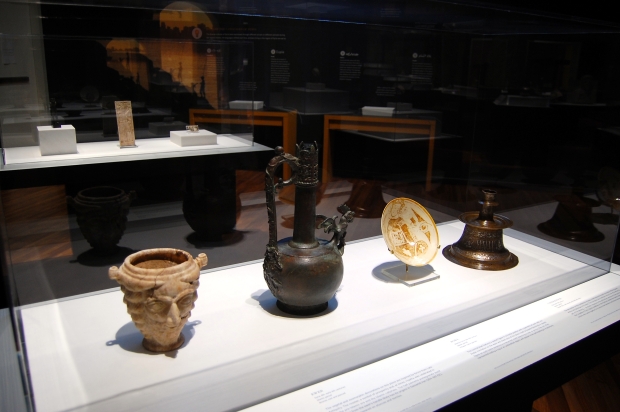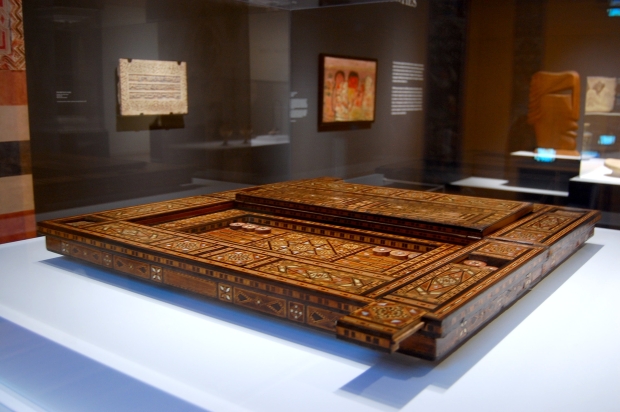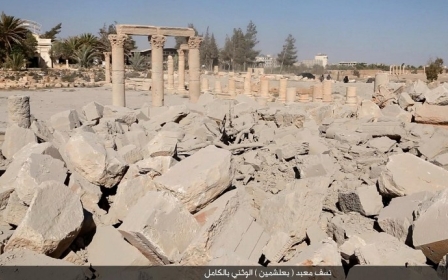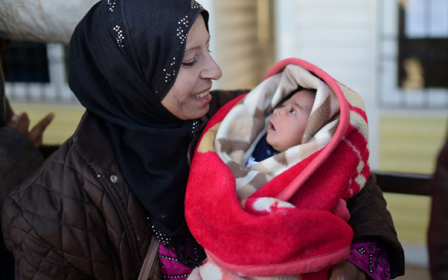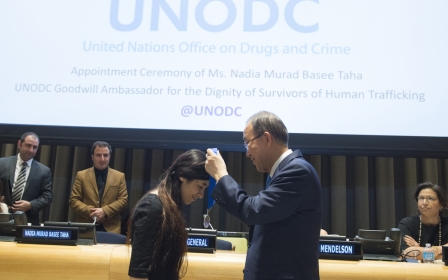Toronto exhibition highlights Syria’s ‘living history’

TORONTO, Canada – As the war in Syria continues, the country has today become intrinsically linked to death, destruction and violence, and waves of displaced families seeking refuge on foreign shores.
But a Canadian museum is seeking to change that narrative, showcasing 5,000 years of art that cuts across the country’s many diverse cultures.
Syria: A Living History draws on Syria’s rich history – and its Mesopotamian, Greek, Roman, Byzantine, Persian, Ottoman and Arab influences – to paint a vivid picture of the country.
From ancient idols and artefacts, to paintings, sculptures, and vases, the exhibition contains 48 objects, two digital reproductions and one virtual reality experience.
“For us, what was most important to be able to emphasise was the fact that Syria is a region, a people, that are made up of many different cultures both today and in the past,” explained Henry Kim, director and CEO of the Aga Khan Museum, an Islamic art museum in Toronto that is hosting the exhibition.
“A lot of times we think about Syrians as being one type of people. Even today so many ethnicities, languages, religions practiced in Syria that it truly defies that one size fits all description of what Syria actually is,” Kim told Middle East Eye.
It is the first time that virtual-reality technology has been used in a North American museum, Kim said.
By moving a tablet in front of them, visitors are transported to the Aleppo Room, a room covered in detailed, red-painted panels that belonged to a Syrian merchant in Aleppo in the 17th Century. The room is on display at Berlin’s Pergamon Museum.
“You actually hold it in front of you like you’re dancing,” Kim said of the experience.
Wide-reaching collaboration
While exhibitions of this nature generally take three years to pull together, Kim explained that Syria: A Living History was conceived, executed and opened to the public in about one year.
He said the museum was moved to act after realising that despite widespread concerns about the preservation of Syrian culture during the war, museums had done very little globally.
The destruction of artefacts in the ancient Syrian city of Palmyra, which holds important archaeological items dating back to the Neolithic period, and the devastating images of Syrian refugees attempting to cross the Mediterranean also pushed the idea forward.
“We felt that with everything that’s happening, we really needed to respond very quickly,” Kim said.
The items on display came to the Aga Khan Museum through collaborations with seven institutions, including the Metropolitan Museum of Art in New York and the Louvre in Paris, as well as private collectors.
One of the objects, an eye idol, dates back to 3200 BCE. Excavated at Tell Barak, an ancient city in northeastern Syria today, the small figurine was likely offered at a temple for spiritual protection, the museum explained.
Other items of note include an ivory lion’s head from the 8th or 9th centuries BCE, which experts say may have served as an armchair ornament, a stone inscription panel from 16th Century Damascus, and a detailed, copper incense burner from the 13th Century.
A section of the Quran dating back to the Mamluk period (1250-1517) is also on display. It is open to the beginning of the Sura al-Isra’ (the Night Journey), which describes how the Prophet Muhammad journeyed from Mecca to Al-Aqsa Mosque in Jerusalem before ascending to heaven to visit unearthly dimensions.
An intricate, wooden backgammon table, complete with colourful, bone and mother-of-pearl designs, also stands out from behind a glass casing. The 19th Century board-game table was likely used for a variety of games, including backgammon (tawla, in Arabic), chess and checkers.
Six contemporary Syrian artists also have their work on display, including Fateh Moudarres, Aktham Abdelhamid, Loftfi al-Romhein, Tammam Azzam and Elias Zayat.
“What can we say about Syria today?” added Nasser Rabbat, director of the Aga Khan program for Islamic Architecture at MIT, and the co-curator of the exhibition, in a statement.
“A country that has for centuries enjoyed a unique mosaic of ethnicities, cultures, religions, and sects. All [of which have] contributed to the rich landscape of Syria and gave it an aura of vivid multiculturalism long before the term itself was coined.”
Hope for the future
Kim said the public’s response to the exhibition has gone beyond what he hoped.
He described meeting a man who was touring the museum who, it turned out, was originally from Aleppo and had recently moved to Canada. More than 33,000 Syrian refugees have been resettled in Canada since December 2015 through private and public sponsorship programmes.
“He had great pride in being able to show his host family the artefacts,” Kim recalled.
The man then stood in front of a photograph near the entrance of the exhibition, and began talking animatedly with his teenage daughter. Puzzled, Kim asked what was going on; the image, the man explained, showed the very same street in Aleppo on which his daughter had gone to school.
“For me, that was one of the most powerful things I’ve ever seen… Seeing people who suddenly were transported back to their home city, a city they’re now refugees from, to be able to see that that’s celebrated, commemorated, in a museum in your new country,” Kim said.
The exhibition ends with an interactive installation that asks visitors to write out what the term “home” means to them, and affix their notes to the superimposed image of Gustav Klimt’s painting The Kiss on a bombed-out, bullet-ridden building in Damascus.
Syrian artist Tammam Azzam first created that juxtaposed image in 2013 in an effort to draw international attention to the situation in Syria.
The installation, Kim said, aims to push visitors “to realise that there’s a future ahead” in Syria.
“And even though we don’t know what that’s going to be, one of these days the war will end and the question is how will Syria and its society and its people rebuild itself during that period of time?” he said.
“Yes, there is destruction, [but] there is something that’s going to come out of this.”
Syria: A Living History is on display at the Aga Khan Museum until 26 February 2017.
New MEE newsletter: Jerusalem Dispatch
Sign up to get the latest insights and analysis on Israel-Palestine, alongside Turkey Unpacked and other MEE newsletters
Middle East Eye delivers independent and unrivalled coverage and analysis of the Middle East, North Africa and beyond. To learn more about republishing this content and the associated fees, please fill out this form. More about MEE can be found here.


